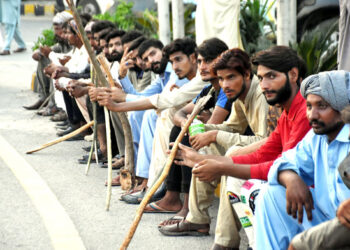ISLAMABAD: The Flood Forecasting Division (FFD) of Pakistan Meteorological Department recorded a high flood of 487,312 cusecs at the Kotri Barrage on Wednesday 12pm as the floodwaters have finally reached the tail end of the Indus River.
The threat of a deluge, however, is far from over. The National Disaster Management Authority (NDMA) has said that a torrent originating from India is likely to enter Pakistan next week, inundating the already battered riverside areas of the country.
In a warning issued on Tuesday night, the NDMA advised the authorities to evacuate people from low-lying areas on the banks of Sutlej, Ravi, and Chenab Rivers.
Destruction marring region
The latest data shared by the NDMA highlighted that in the past 24 hours at least 54 more people were killed and six were injured in the flood-related incidents. Since mid-June, the death toll has 1,481.
Around 4,000 houses have so far been destroyed by the deluge while 81 districts are still bearing the brunt of the ‘monsoon on steroids’.
The recent visit of the United Nations Secretary-General has brought world attention to the greatest climate-induced calamity in Pakistan. Help is pouring in, but it is still not enough.
As per the information shared by SAMAA correspondent, the flood has left thousands homeless Qasim Bela area of Multan and at the mercy of donors.
Dozens of settlements have also been razed to the ground by the incessant downpour and subsequent floods.
Residents continue to appeal to the government to supply relief goods to prevent an aggravated humanitarian crisis as they try to survive in dire circumstances. In the south, Sindh too is marred by high floods and a plethora of waterborne diseases.
Sindh Chief Minister Murad Ali Shah has said around 600,000 cases of skin ailments have been registered in the province, whereas at least 12,229 cases of dengue are also creating an alarming situation. He said so far 172 deaths have been reported in the region but he claimed, “The situation is far worse.”
The flood has endangered the lives of thousands of pregnant women in the country. In Punjab alone, thousands of births are expected under dangerous circumstances. More than 100,000 women will give birth in camps.
The absence of adequate pre and post natal care has left thousands of babies and women vulnerable to health issues.
In Dera Ghazi Khan 50,000 pregnant women are at risk, followed by at least 32,000 in Rajanpur district of Punjab.
Health experts are lobbying for arranging mobile toilets for expectant mothers, as well as demanding psychological assistance to the flood-torn vulnerable sections of society. According to the report of the Population Council, over 330,000 women in the flood-affected areas of Punjab have more than five children.
The organization also noted that more than 940,000 children under the age of five are suffering from malnutrition in the flood-affected areas of Punjab, and over 200,000 elderly people need special assistance to survive. NNI
















